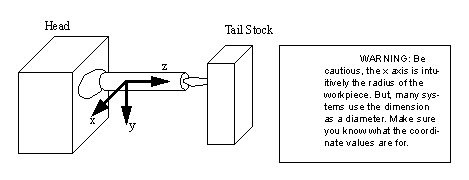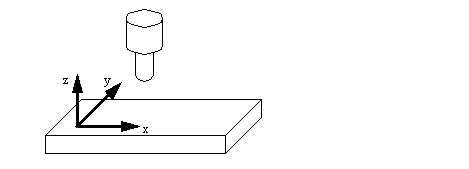1. CNC PROGRAMMING• We need to be able to direct the position of the cutting tool. As the tool moves we will cut metal (or perform other processes). • Obviously if we plan to indicate positions we will need to coordinate systems. • The coordinates are almost exclusively cartesian and the origin is on the workpiece. • For a lathe, the infeed/radial axis is the x-axis, the carriage/length axis is the z-axis. There is no need for a y-axis because the tool moves in a plane through the rotational center of the work. Coordinates on the work piece shown below are relative to the work. 
• For a tool with a vertical spindle the x-axis is the cross feed, the y-axis is the in-feed, and the z-axis is parallel to the tool axis (perpendicular to the table). Coordinates on the work piece shown below relative to the work. 
• For a tool with a horizontal spindle the x-axis is across the table, the y-axis is down, and the z-axis is out. Coordinates on the work piece shown below relative to the work. 
• Some common programming languages include, (note: standards are indicated with an *) ADAPT - (ADaptation of APT) A subset of APT *APT - (Automatically Programmed Tool) A geometry based language that is compiled into an executable program. AUTOSPOT - A 2D language developed by IBM. Later combined with ADAPT. COMPACT/COMPACTII - A higher level language designed for geometrical definitions of parts, but it doesn’t require compilation. EXAPT - A european flavor of APT *G-Codes (EIA RS-274 G&M codes) MAPT - (Microcomputer APT) - Yet another version of APT UNIAPT - APT controller for smaller computer systems • These languages have many similarities, but the syntax varies. 1.1 G-CODES1.2 APT1.3 PROPRIETARY NC CODES1.4 GRAPHICAL PART PROGRAMMING1.5 NC CUTTER PATHS1.6 NC CONTROLLERS1.7 PRACTICE PROBLEMS |